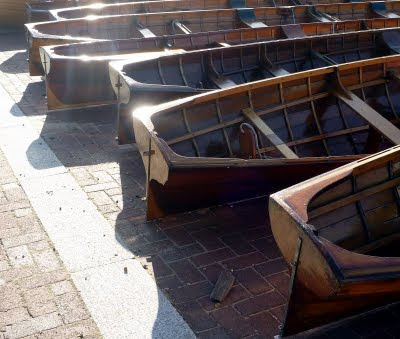 Clint Chase writes from Portland, Maine, having stumbled on my recent post about his new Drake rowboat:
Clint Chase writes from Portland, Maine, having stumbled on my recent post about his new Drake rowboat:I just saw Drake on one of your Blog posts. I don't know how I missed that. You've been linked on my website. Great blog, keep it up. How do we cross link our blogs? Mine is www.clintchaseboatbuilder.blogspot.com.Clint's blog is excellent, and I have linked to it right over there -------->
I plan to post more on water and rowing stuff. Also, FYI, I am developing a line of wood-composite oars that I think may be popular. They'll have spruce looms with carbon fiber, epoxy infused blades. Pretty snazzy. More coming on this front.
Also, you mention liking Gartside's work. I love his Flashboat design. Have you rowed one? I am eyeing that boat as a potential one to do in composite if there might be a market here in the States. The kevlar guideboats are a hit, so I don't see why Flashboats wouldn't except that they are from across the pond so may take a little longer to catch on.
Cheers,
Clint Chase
Wednesday's post is particularly insightful, I think, with a couple of really nice pics too. Clint takes two pairs of oars with him when rowing. One pair is long with wide blades for maximum oomph in flat water, the other shorter with narrow blades for rowing through a chop, especially upwind. They allow a higher stroke rate, and the narrow blades mean you don't need to feather.
I really like Clint's combination wood/carbon fibre oars too.
Carbon fibre shafts bend alarmingly and, frankly, are pig-ugly. But wooden blades are heavy and delicate. So an oar with a lovely varnished spruce shaft and a light but tough carbon fibre blade really appeals. And once the blade is painted the neighbours need never know.
Clint is developing a vacuum infusion process (VIP) for making the blades, in which the carbon fibre mats are held against an inner core in a vacuum bag. The resin is then allowed to enter and is drawn through the carbon fibres by the vacuum, to create a blade with no bubbles and little wasted resin. The result should be an oar with the loveliness and strength of wooden shafts and the lightness and indestructibility of carbon fibre blades. I want a set already...
I have never rowed a flashboat, but they are hugely popular in Cornwall where they are raced with total Cornish aggression. A bit tippy for popular taste, I think, but slippy as hell.
Flashboats arose at a time when race rules were relaxed, allowing boatbuilders to go bonkers in the pursuit of speed. So a kevlar flashboat would be entirely within the flashboat ethos, I feel.












































